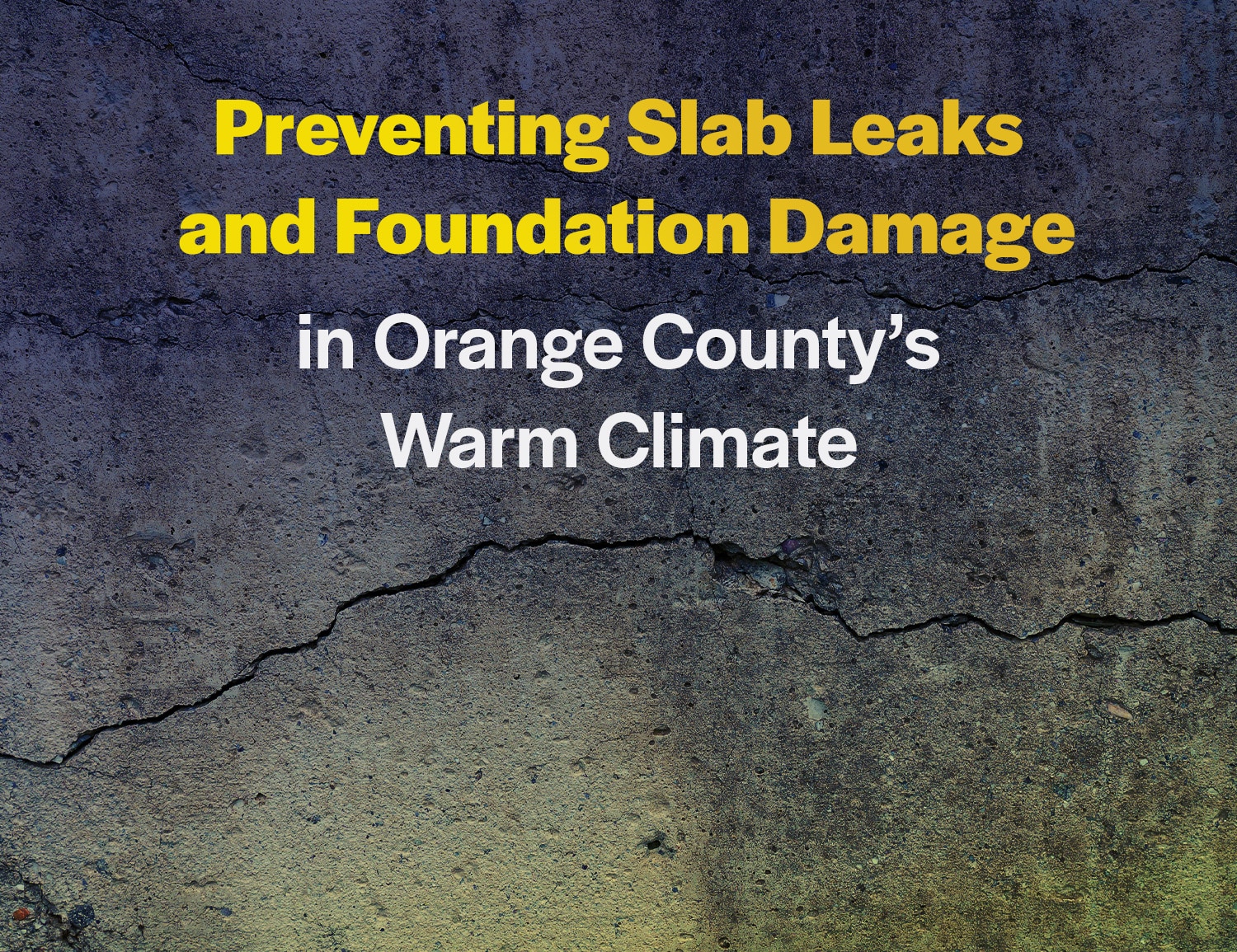
Orange County’s year‐round warmth and dry spells create conditions that put concrete slab foundations and plumbing systems under constant stress. When slab leaks develop, they can undermine structural integrity, lead to costly repairs, and even pose health risks through mold or mildew. Understanding how desert‐like climate factors, irrigation trends, and early warning signs contribute to slab leaks is essential for homeowners who want to protect their investment.
The Climate Factor: Heat, Dryness, and Soil Movement
In Orange County, we don’t see the freeze–thaw cycles like the north regions, but we do experience significant temperature swings between hot days and cooler nights, very dry air, and soil that expands and contracts with moisture changes. Some of the main climate‐related risk factors include:
- Dry soil shrinkage: During long, hot, dry spells, clay soils or loam can dry out and shrink, causing the ground beneath a slab to settle or subside. This leaves gaps under sections of the slab where stress gets concentrated.
- Sudden rehydration: When irrigation or rainfall returns, soil can swell or expand quickly. That process can shift or lift slabs, stressing joints, plumbing pipes, or even causing cracks in concrete.
- Continuous exposure to heat: High temperatures can degrade plumbing fittings, accelerate corrosion in certain materials, and weaken seals. PVC, copper, or older metal lines under slabs may be more vulnerable in extreme warmth.
Irrigation Trends and Their Role in Slab Leak Risk
Irrigation in Orange County has evolved significantly: many homeowners have adopted automated sprinkler systems, drip lines, and timed watering to conserve water. While these are good in principle, mismanagement of irrigation can worsen foundation and slab issues.
- Over‐watering: Keeping soil constantly moist under the slab, or allowing run‐off to pond, can saturate and wash away soil, or lead to root intrusion into plumbing. Constant saturation may shift soil density and stress pipe joints.
- Underground leaks from irrigation: A leak in an irrigation line beneath or near the slab can stay hidden for a long time. The soil will absorb water and likely seem fine until the damage is severe enough to crack pipes or lift sections of concrete.
- Inconsistent watering and cycles: Deep soaking followed by long dry periods causes soil to alternately expand and contract. That repeated movement stresses both foundation and any plumbing running through the slab.
Risks to Slab Integrity & Underground Plumbing
Slab foundations are common throughout Orange County, and plumbing is often embedded within or directly under the concrete. Some of the risks include:
- Pipe joints under slab: Soldered or threaded joints in copper, cast iron, older galvanized steel, or older PVC may not flex well. Soil movement or shifting concrete can cause small leaks at these joints.
- Corrosion and material fatigue: Over time, materials degrade. If pipes are corroded—or installed poorly, with insufficient bedding under them—they become more susceptible to leaks.
- Concrete cracking: Slabs themselves may crack due to soil movement, poor compaction, or seismic activity. Cracks allow moisture intrusion, which can lead to underground plumbing being exposed to harmful conditions.
- Settling or voids: If soil beneath slabs washes out (from poor drainage or leaking irrigation), voids can form, leading to collapse or uneven settling that breaks pipe seals or bends lines.
Early Warning Signs Every Homeowner Should Know
Detecting slab leak problems early can save tens of thousands of dollars, both in plumbing repair and foundation work. Look out for:
- Unexplained increase in water bills: If water usage spikes but you haven’t changed usage habits, you may have a leak.
- Hot spots on the floor: Pipes under slab often carry hot water lines. If portions of a floor feel warm for no reason, that may indicate leaking hot water under the concrete.
- Damp, warm, or humid spots on the slab or near walls: Moisture seeping through cracks or along expansion joints is a red flag.
- Mold or mildew growth indoors: Dark, damp areas under carpets or behind baseboards can signal moisture intrusion from beneath.
- Cracks in walls or floors: Cracking in tile grout, floor tiles, or drywall near the slab may result from shifting foundation or moisture weakness.
- Uneven or sagging floors: Floors that begin to slope or bounce may indicate underlying soil erosion or foundation settling.
- Sounds of running water: Even when no faucets are on, hearing water movement under the slab can mean a leak.
Prevention Strategies: What Orange County Homeowners Should Do
To avoid slab leaks and foundation damage in our region’s warm, dry climate, taking proactive steps can help:
- Proper irrigation design & maintenance
- Adjust irrigation schedules to avoid constant saturation.
- Ensure sprinkler heads don’t spray directly onto the house or foundation.
- Water‐efficient landscaping
- Use drought‐tolerant plants.
- Minimize turf areas near foundations—because grass requires more frequent watering.
- Use mulch or ground cover to reduce evaporation and moderate soil moisture swings.
- Ensure good drainage around foundation
- Grade soil away from the house so water runs off.
- Use gutters and downspouts, directing runoff well away from any slabs.
- Quality installation and materials
- Pipes under slabs should be fitted with joints that provide flexibility.
- Use durable materials suitable for our soil chemistry and climate (e.g. non‐corroding pipes, protective sleeves for pipes going through concrete).
- Scheduled inspections & leak detection
- Regularly inspect plumbing, especially if symptoms appear.
- Use professional leak detection services to locate hidden leaks before they become catastrophic.
What to Do If You Suspect a Slab Leak
If you notice any of the early warning signs above, it’s important to act promptly:
- Call a specialized plumbing service that offers slab leak detection using advanced tools (e.g. acoustic sensors, thermal imaging) rather than guesswork.
- Limit water usage until the source is located so you don’t saturate soil or worsen foundation issues.
- Document and monitor: Take photos of cracks, wet spots, or any new development so that when a plumber visits, you have clear evidence.
- Be cautious of temporary fixes: Patching visible cracks may mask deeper issues; only a thorough inspection can reveal the extent of damage.
Orange County’s warm, dry climate offers many benefits, but it also places homes at risk for slab leaks and foundation damage—especially when soil moisture varies wildly, irrigation is poorly managed, or plumbing is not properly designed or maintained. By understanding the causes, recognizing early warning signs, and taking preventive action, homeowners can protect their slab foundations, avoid costly repairs, and enjoy peace of mind.
For expert leak detection, foundation protection, or plumbing inspections under slab foundations, VIP Sewer & Drain Services is here to help. Contact us to schedule a professional assessment before small problems become large, expensive ones.


